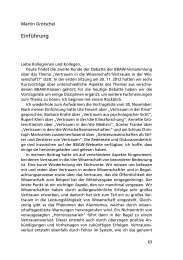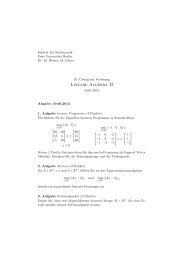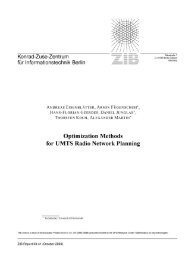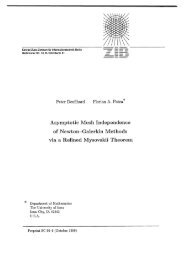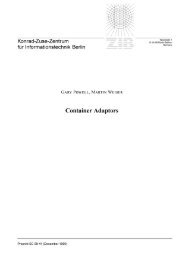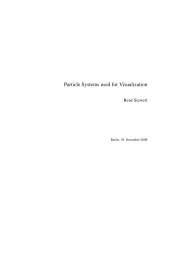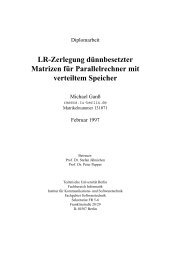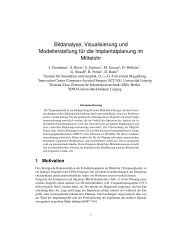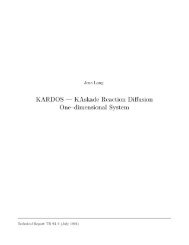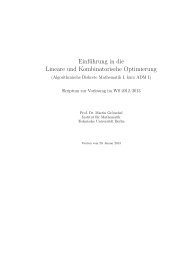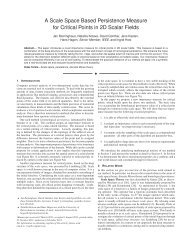Implementation of Cutting Plane Separators for Mixed Integer ... - ZIB
Implementation of Cutting Plane Separators for Mixed Integer ... - ZIB
Implementation of Cutting Plane Separators for Mixed Integer ... - ZIB
You also want an ePaper? Increase the reach of your titles
YUMPU automatically turns print PDFs into web optimized ePapers that Google loves.
2.2 Lifting Theory 7<br />
1. If there exists λ > 0 such that (α, α0) = λ(γ, γ0), we call α T x ≤ α0 and<br />
γ T x ≤ γ0 equivalent.<br />
2. If there exists µ > 0 such that γ ≥ µα and γ0 ≤ µα0, then {x ∈ R n + : γ T x ≤<br />
γ0} ⊆ {x ∈ R n + : α T x ≤ α0}. In this case, we say that γ T x ≤ γ0 is at least as<br />
strong as α T x ≤ α0.<br />
We assume that the MIP has an optimal solution, i.e., that the MIP is neither<br />
infeasible nor unbounded. The general cutting plane method starts by solving the<br />
LP relaxation <strong>of</strong> the MIP with methods from linear programming (see e.g. [52]).<br />
Obviously, zLP ≤ zMIP holds. Let x∗ LP be an optimal solution <strong>of</strong> the LP relaxation <strong>of</strong><br />
the MIP. If x∗ LP is in Zp × Rn−p , we are done; x∗ LP is an optimal solution <strong>of</strong> the MIP.<br />
Otherwise, it is a well-known result that there exists a valid inequality <strong>for</strong> X that is<br />
from conv(X) (see [46]). Such an inequality is<br />
not satisfied by x∗ LP , or ‘cuts <strong>of</strong>f’ x∗ LP<br />
called cutting plane and the problem <strong>of</strong> determining whether x∗ LP<br />
is in conv(X) and<br />
if not <strong>of</strong> finding a cutting plane is called separation problem. If we found a cutting<br />
plane, we add it to P and obtain a polyhedron Q with conv(X) ⊆ Q ⊂ P . This<br />
process is iterated until the solution is in Z p × R n−p , i.e., an optimal solution <strong>of</strong> the<br />
MIP is found.<br />
The separation problem can be <strong>for</strong>mulated <strong>for</strong> different class <strong>of</strong> valid inequalities<br />
<strong>for</strong> X. Gomory has shown that a cutting plane method based on iteratively adding<br />
Gomory mixed integer cuts (see Chapter 6) solves a MIP under certain conditions<br />
in a finite number <strong>of</strong> steps (see [40, 46]).<br />
MIPs can also be solved by the linear programming based branch-and-bound algorithm.<br />
The algorithm uses a divide-and-conquer strategy to explore the feasible<br />
region <strong>of</strong> the MIP and there<strong>for</strong>e guarantees to find an optimal solution, if one exists.<br />
But, instead <strong>of</strong> exploring the whole feasible region, it makes use <strong>of</strong> lower and<br />
upper bounds and there<strong>for</strong>e avoids touching certain (large) parts <strong>of</strong> the feasible region<br />
(see [27]). This algorithm can be used in combination with the general cutting<br />
plane method described above. For a MIP in minimization <strong>for</strong>m the cutting plane<br />
method can help to improve the lower bound used in the branch-and-bound algorithm<br />
(also called dual bound). The resulting algorithm is called linear programming<br />
based branch-and-cut algorithm. We do not give a detailed description here, but refer<br />
the interested reader to [27, 46].<br />
2.2 Lifting Theory<br />
For implementing efficient cutting plane separators, it seems important to use cutting<br />
planes that are strong in the sense that they define facets <strong>of</strong> conv(X), where X is the<br />
feasible region <strong>of</strong> the MIP, or at least faces <strong>of</strong> conv(X) <strong>of</strong> reasonably high dimension<br />
(see [46]).<br />
Definition 2.7 ([46]). Let P ⊆ R n be a polyhedron, and α T x ≤ α0, where α ∈ R n<br />
and α0 ∈ R, be a valid inequality <strong>for</strong> P .<br />
1. A set <strong>of</strong> vectors x1 , . . . , xk ∈ Rn is affinely independent if the unique solution<br />
<strong>of</strong> k i=1 λixi = 0, k i=1 λi = 0 is λi = 0 <strong>for</strong> i = 1, . . . , k.



